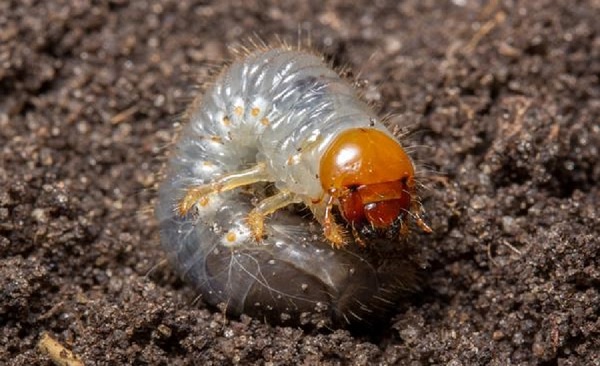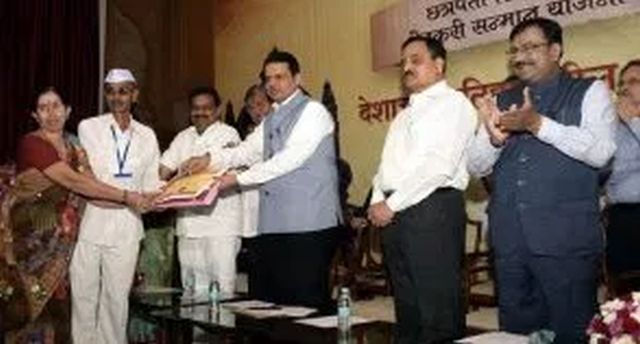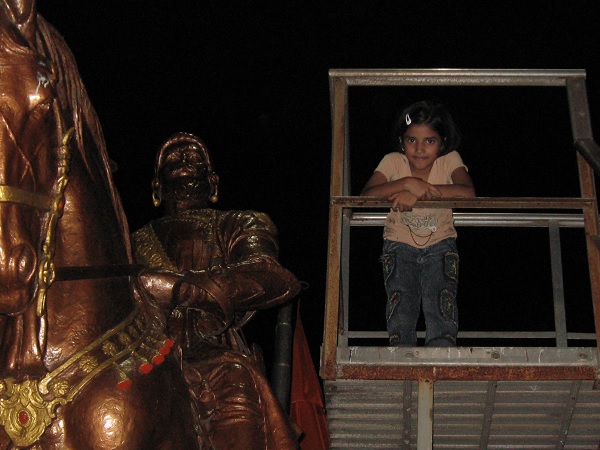
by admin | May 25, 2021 | Commodities, News

The white grubs have apparently spread from the western part of the state where they have played havoc over the years, destroying sugarcane crops.
While Covid-19 continues to play havoc in the state’s least developed regions of Vidarbha and Marathwada, soyabean and cotton farmers are now confronting a new pest that threatens to destroy their crops
Ashok Kumar | Mumbai
Farmers in Vidarbha and Marathwada, two of the most backward regions of Maharashtra, who have been battling the Covid-19 crisis are now facing a new challenge – the rapid spread of a relatively new pest to the region, the white grub beetles (Holotrichia serrate).
The immature larvae of several species of scarab beetles, the white grubs have apparently spread from the western part of the state where they have played havoc over the years, destroying sugarcane crops. The state’s agriculture department had said that the pest had infested nearly 15 per cent of the 11 lakh hectares of cane area about two years ago in the western part, especially Pune and Solapur districts.
Devanand Pawar, general secretary of the Maharashtra Pradesh Kisan Congress (MPKC), told Clarion India on Tuesday that the farmers cannot see the white grubs as they are underground most of the time. “It is only when we dig that we find them,” said the farmer-leader. “But these beetles destroy the roots and soyabean and cotton crops in Vidarbha and Marathwada get damaged badly.”
The Sugarcane Breeding Institute of the Indian Council of Agricultural Research had in its report on white grub as a pest of sugarcane and its management noted that the grubs can withstand drought conditions by remaining dormant; deforestation is also responsible for its extensive spread. Many districts in both Vidarbha and Marathwada face drought-like conditions every year.
Interestingly, Shree Vighnahar Cooperative Sugar Mill, a Pune-based outfit, has for years encouraged farmers in western Maharashtra to launch a campaign against the pests and to catch the beetles. It proved to be quite a success, with farmers trapping nearly 30 lakh beetles and handing them over to the mill, which paid them almost Rs10 lakh. The Maharashtra government plans to replicate the programme elsewhere in the state.
But with Covid-19 continuing to rage across Vidarbha and Marathwada, government officials feel that this year it would be difficult to tackle the white grubs menace. In Vidarbha, which covers 11 districts including Nagpur, more than 1,200 people have died because of Covid-19. More than 800 of them succumbed in August. Marathwada has seen more than 1,300 deaths in its eight districts.

by admin | May 25, 2021 | News, Politics
 Mumbai : Nearly five months after announcing waiver of farm loans, the Maharashtra government kickstarted the process on Wednesday as “Diwali gift” to the state’s farmers. Rs 4,000 crore will be distributed among 840,000 beneficiaries in the first phase of the massive Rs 34,000-crore scheme.
Mumbai : Nearly five months after announcing waiver of farm loans, the Maharashtra government kickstarted the process on Wednesday as “Diwali gift” to the state’s farmers. Rs 4,000 crore will be distributed among 840,000 beneficiaries in the first phase of the massive Rs 34,000-crore scheme.
At a function, Chief Minister Devendra Fadnavis launched a portal in which the names of the beneficiary farmers were uploaded which will be sent to the banks.
From a single bank account, the money would be transferred to various banks, which in turn would deposit the pre-defined amounts in the individual farmers’ accounts as per the list, he said.
“We have released today (Wednesday) an amount of Rs 4,000 crore, of which Rs 3,200 crore will go towards loan waivers of 462,000 farmers and the rest Rs 800 crore would be paid as incentives to 378,000 farmers who have been repaying their loans on time,” Fadnavis said.
He assured that payments funds under the Chhatrapati Shivaji Shetkari Sanman Yojana would be a continuous process till every eligible farmer was benefited, and by November 15 around 75 per cent of disbursals would be completed.
According to Fadnavis, government employees who also earn income from agricultural activities, legislators and others who are regular income tax payers have been exempted from the scheme.
However, the Chief Minister made it clear that loan waiver was not the sole solution to farmers’ problems and reiterated that continuous investment in the agricultural sector for the next five years would enable sustainable development besides reducing distress in farms.
“Our aim was to help those farmers, who had stepped outside the institutional credit systems, return to the system so that they don’t get stuck in the debt-trap of private money-lenders, and also ensure they can avail fresh loans from financial institutions, earn profits and repay them,” Fadnavis explained.
Detailing schemes for the farmers, he said the investments amounting to Rs 21,000 crore in 2011-2012 had now increased three-fold and stood at around Rs 63,000 crore in the agriculture sector.
Besides, schemes like the Jalyukt Shivar water conservation initiative contributed to ensure a growth rate of up to 12 per cent in the agriculture sector, which was ensuring production worth over Rs 40,000 crore in actual terms, he said.
Fadnavis said farmlands had been experiencing many problems for the past few years, resulting in negative growth and that was the reason the government looked at options beyond relief and rehabilitation.
The Chief Minister admitted that he was initially apprehensive about the additional financial burden of the loans waiver scheme on the state exchequer, but with the help of Finance Minister Sudhir Mungantiwar, the government finally managed the herculean task.
On June 24, the state government had announced a massive Rs 34,022 crore relief package for the farmers, days after an unprecedented 11-day strike by the farming community in the state shook the ruling establishment.
Under the scheme, the total number of beneficiaries were estimated to be around 8.90 million, but now it is expected that over four million, mostly small and medium farmers, shall become completely debt-free, becoming eligible to avail fresh bank loans.
—IANS

by admin | May 25, 2021 | Opinions

Chatrapati Shivaji Maharaj statue at Thane in Maharashtra(Photo;Maeeshat)
By Ram Puniyani
Some concerned citizens have filed a Public Interest Litigation (August 17 2015) to stop the highest award of Maharashtra Government, Maharashtra Bhushan to Babasaheb Purandare. Purandare is known for his work ‘Raja Shivaji Chatrapati’ and the play ‘Jaanata Raja’ (wise king) his is not the first time that such a controversy around Purandare has come up. Few years ago Maharashtra Government had appointed him as Chairman of the Committee which was to plan the statue of Shivaji in Arabian Sea. The Maratha Mahasangh objected to this appointment on the ground that Shivaji was a Maratha while Purandare is a Brahmin. Purandare’s interpretation of Shivaji presents him as the one who was devoted to Brahmins and Cows (Go Brahman Pratipalak) and the one who was against Muslims. This interpretation of Shivaji has been the major version used by sectarian political groups. As this on one hand presents him as upholder of supremacy of upper caste and at the same time looks down upon Muslim kings.
Maharashtra has seen many a controversies on Shivaji issue times and over again. There was an attack on Bhandarakar Oriental Research Institute (BORI), Pune few years ago. The issue at that time was that this institute had helped the western author James Laine for writing his book, ‘Shivaji: Hindu King in Islamic India’. In this book he had cast aspersions on Shivaji’s mother by mentioning some rumors. Maratha-Brahmin politics was at the root of this. BORI is regarded more as being Brahminical. In yet another controversy, just before the elections in Sangli area (2009), the poster of Shivaji killing Afzal Khan with a knife, was the provocation for communal violence, in which one person was killed and a tense atmosphere was created. The symbolism was that Shivaji is representing Hindus while Afzal Khan represents Muslims. This is the fertile ground for hatred and the consequent violence, which polarized the communities and the communal forces won the election.
One recalls another controversy around Shivaji and that was when the Human rights activist Teesta Setalvad had prepared a hand book of history for school teachers in which she narrated the incident of Maharashtra Brahmins refusing to coronate Shivaji as he was a Shudra. The priest from Kashi; Gaga Bhat; had to be invited, who did coronate him but with the little toe of the left foot, as that is the organ which according to Brahmanical norms is lowest in the body hierarchy.
The local Shiv Sainiks objected to this handbook on the ground that how dare someone call Shivaji as Shudra? History has its own truth and emotions operate on different wavelength! What is true is that Shivaji was a King who reduced the burden of taxation on the poor peasants. That’s what made him popular amongst the masses. Also the legend of Shivaji asking his army to return the Muslim daughter in law of Kalyan’s Nawab is a matter of deep respect for him amongst the people of Maharashtra. The memories of his policies towards the rayyat (cultivating farmers) make him very revered figure in Maharashtra.
Lokmanya Tilak was the first one who recalled Shivaji’s role by organizing a Shivaji festival. Tilak presented him as protector Brahmins and Cows. Since then Shivaji came back in the social memory but with upper caste orientation. The later popularization of Shivjai was done by communal forces that centered the narration on Shivaji’s battles with Aurangzeb and Afzal Khan. This was in a build up to Shivaji’s own kingdom. These battles with these two Muslim kings are highlighted while Shivaji’s battles with Hindu kings are underplayed or omitted from the recall. While his battle with Aurangzeb was for power; the official who came from Aurangzeb’s side was Raja Jaisingh who was a big official in Aurangzeb’s administration. In case of Afzal Khan it was Shivaji’s Muslim body guard who advised him to carry the iron claws, while on Afzal Khan’s side we see Krishnaji Bhaskar Kulkarni as his secretary. The battles for power have been given religious color.
Today Shivaji on one side is being used for sharpening communal (Hindu Muslim divides) and on other hand between Brahmin-Marathas.
The rational understanding of Shivjai has been excellently presented by late Com. Govind Pansare in his very popular book Shivaji kon Hota? (Who was Shivaji?) Com Panasre’s you tube video is also a brilliant watch, ‘Janatecha Raja Shivaji’. One need to realize that the shadow boxing around Shivaji is in a way is reflection of the underlying communal politics and caste struggles. Real Shivaji needs to be understood so that we can undermine these sectarian tendencies.




